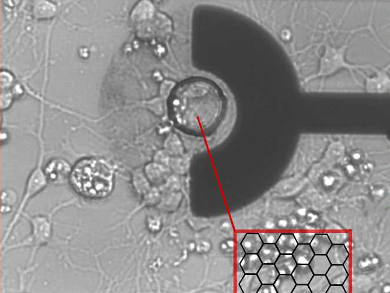Microelectrodes can be used to stimulate neural cells and record their activity. They are useful, for example, in cochlear and retinal implants, but also to study the communication in neuronal networks. Microelectrodes based on graphene are small, flexible, and transparent, and they can provide a large safe potential range for stimulation.
Christiane Thielemann, University of Applied Sciences Aschaffenburg, Germany, Jörg J. Schneider, Technical University Darmstadt, Germany, and colleagues have studied graphene-based microelectrodes (example pictured), investigated their recording and stimulation properties, and evaluated their suitability for neuronal implants. The team compared three different electrode compositions: gold, graphene on gold, and plain graphene on a glass substrate. They prepared microelectrode arrays with an electrode size of about 700 μm2 from all three materials, using standard photolithography techniques.
The electrode arrays were characterized using Raman spectroscopy, microscopy, and electrochemical measurements, and their signal-to-noise ratios were tested using neuronal cell cultures. The researchers found that graphene-coated gold electrodes provide a lower impedance, whereas plain graphene electrodes inject more charges for stimulation. This means gold/graphene electrodes have better recording properties, while plain graphene electrodes might be better suited for stimulation applications, such as in neuronal implants. Both materials provided sufficient signal-to-noise ratios.
- Electrochemical Characterization of Graphene Microelectrodes for Biological Applications,
Berit Körbitzer, Peter Krauß, Stefan Belle, Jörg J. Schneider, Christiane Thielemann,
ChemNanoMat 2019.
https://doi.org/10.1002/cnma.201800652




